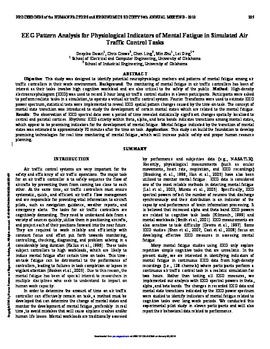| dc.contributor.author | Deepika Dasari | |
| dc.contributor.author | Chris Crowe | |
| dc.contributor.author | Chen Ling | |
| dc.contributor.author | Min Zhu | |
| dc.contributor.author | Lei Ding | |
| dc.date.accessioned | 2016-01-14T19:53:46Z | |
| dc.date.accessioned | 2016-03-30T15:35:24Z | |
| dc.date.available | 2016-01-14T19:53:46Z | |
| dc.date.available | 2016-03-30T15:35:24Z | |
| dc.date.issued | 2010-09-01 | |
| dc.identifier.citation | Dasari, D., Crowe, C., Ling, C., Zhu, M., & Ding, L. (2010). EEG Pattern Analysis for Physiological Indicators of Mental Fatigue in Simulated Air Traffic Control Tasks. Proceedings of the Human Factors and Ergonomics Society Annual Meeting, 54(3), 205-209. doi: 10.1177/154193121005400304 | en_US |
| dc.identifier.uri | https://hdl.handle.net/11244/25442 | |
| dc.description.abstract | Objective: This study was designed to identify potential neurophysiologic markers and patterns of mental fatigue among air traffic controllers in their work environment.Background: The monitoring of mental fatigue in air traffic controllers has been of interest as their tasks involve high cognitive workload and are also critical to the safety of the public.Method: High-density electroencephalogram (EEG) was used to record 2-hour long air traffic control studies in eleven participants. Participants were asked to perform realistic tasks in a simulation, to operate a virtual air traffic control system. Fourier Transforms were used to estimate EEG power spectrum, statistical tests were implemented to reveal EEG spatial pattern changes caused by the time-on-task. The concept of mental state transition was introduced to study the development of certain mental states which are related to the mental fatigue. Results: The observation of EEG spectral data over a period of time revealed statistically significant changes spatially localized to central and parietal cortices. Rhythmic EEG activity within theta, alpha, and beta bands indicates transitions among mental states, which appear to be promising indicators for the development of mental fatigue. Mental fatigue indicated by the transition of mental states was estimated to approximately 70 minutes after the time on task. Application: This study can build the foundation to develop promising technologies for real time monitoring of mental fatigue, which will increase public safety and proper human resource planning. | en_US |
| dc.language.iso | en_US | en_US |
| dc.publisher | Proceedings of the Human Factors and Ergonomics Society Annual Meeting | |
| dc.title | EEG Pattern Analysis for Physiological Indicators of Mental Fatigue in Simulated Air Traffic Control Tasks | en_US |
| dc.type | Research Article | en_US |
| dc.description.peerreview | Yes | en_US |
| dc.description.peerreviewnotes | https://us.sagepub.com/en-us/nam/manuscript-submission-guidelines | en_US |
| dc.identifier.doi | 10.1177/154193121005400304 | en_US |
| dc.rights.requestable | false | en_US |
